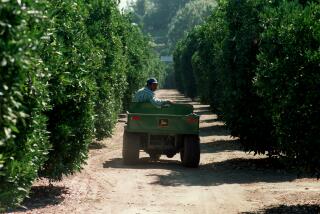Cemetery vines to holy wine
- Share via
HAYWARD, CALIF. — A graveyard vineyard in this East Bay city could yield some wholly delightful results for Catholic cemetery officials who are growing vines on surplus land in hopes of making sacramental wine.
Zinfandel and cemeteries might seem an unlikely pairing, but there’s an ancient link between wine and the church -- for example, the water-into-wine miracle of the wedding at Cana and the Last Supper, says Robert Seelig, director of funeral and cemetery services for the Roman Catholic Diocese of Oakland.
“Wine and the blood of Christ is very much a strong symbol,” he said. “We’re always looking for signs and symbols to place in the cemetery whether it’s a statue of a saint or some building. People like those things.”
But the project started out with beautification, not vinification, in mind. Faced with unused land that needed sprucing up, the church was looking at somewhere in the neighborhood of $50,000 per acre for weed-free, irrigated turf as opposed to $25,000 for vines.
Grapes beat grass and a three-acre vineyard was planted on the outskirts of Holy Sepulchre Cemetery in Hayward, a suburb about 20 miles southeast of San Francisco.
For now, the nearest graves are about 60 feet from the grapes. Seelig said it was possible that people would request burial plots closer to the vines.
After consultation with people in the wine business, the diocese hired a vineyard management contractor to plant zinfandel, chardonnay and pinot noir grapes on the cemetery’s west-facing slopes.
“We talked about merlot, but we know the merlot market is flooded right now,” said Tom Richardson, operations director for diocesan cemeteries and a quick study in the switch from landscaping to winemaking.
“Pinot noir is supposed to be up and coming so we thought, ‘Well, let’s put in a little more pinot noir,’ ” he said.
Funerals are the main business of Holy Sepulchre; the vines are just a sideline, albeit a fun one.
They started out with no background in viticulture “other than drinking wine,” Seelig joked. But “we’d have meetings and you’d have people come in and they’d tell us how to do this stuff and you start learning as you go along.”
At the California Assn. of Winegrape Growers in Sacramento, President Karen Ross wasn’t quite sure what to make of the cemetery planting.
She pointed out that with cemeteries often surrounded by farmland, “the chances of having a vineyard as a next-door neighbor to a cemetery isn’t all that farfetched ... but I just can’t think of any.”
Still, the idea “makes great sense to me,” she added. “Wine and the church and the spirituality of wine and the service -- it’s a very natural combination.”
After all, Franciscan friars brought wine grapes to California, and a few wineries kept going during Prohibition by making limited amounts of still-legal sacramental wine.
“There were many, many more people taking part in sacrament from what I’ve heard,” Ross said.
It would take a few years for the new grapes to produce, but they could yield about 300 cases a year.
Seelig plans to start with sacramental wine, not so much a premium brew. If the wine turns out tasty, it may be used for parish fundraising dinners or be sold in diocesan gift shops.
If things go really well, they might just put out a Bishop’s Private Reserve. Oakland diocesan leader Allen Vigneron has the perfect name.
Vigneron is French for vine grower.


